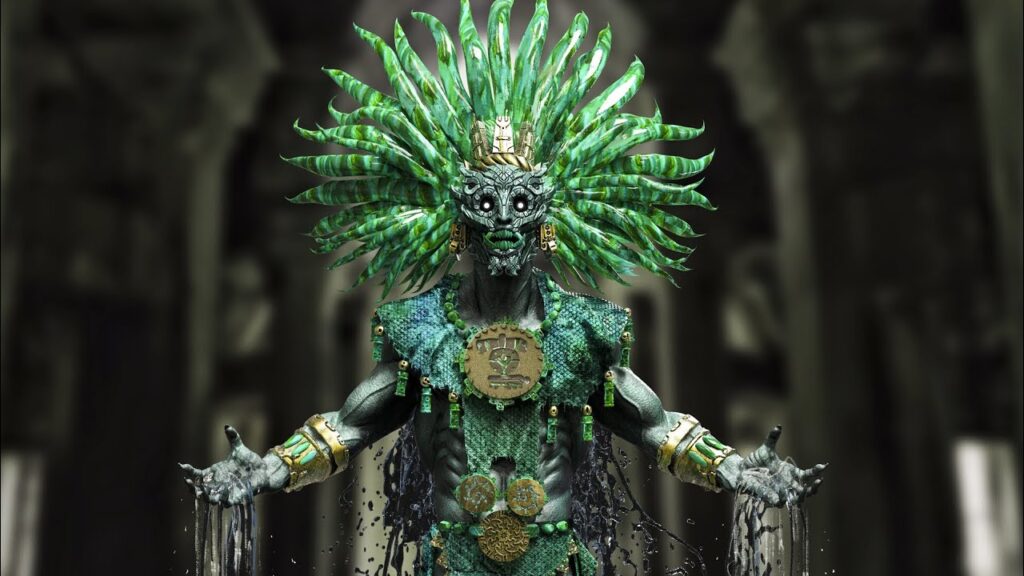Discover the Tlaloques: Tláloc’s Rain-Making Helpers
In the heart of Mexican mythology lies a pantheon of ancient deities, amongst which the Tlaloques play a unique and crucial role. These lesser-known divine helpers are said to be assistants to Tláloc, the prominent god of rain, water, and fertility. According to the myths, the Tlaloques take charge of the distribution of rain, ensuring that the vital resource falls where it is most needed across the diverse landscapes of Mexico.
The Tlaloques are often depicted as dwarfish beings, living atop mountains and in high places close to the clouds where they can gather moisture. Their dwelling place is said to be the Tlalocan, a paradisiacal realm within the mountains, a place deemed to be a home for souls blessed by water, as well as the birthplace of the very rain that sustains life in the arid regions of the country.
Each Tlaloque is responsible for a specific type of rain, which they carry in earthenware pots. From light misting drizzles to booming thunderstorms, the Tlaloques ensure that every type of rainfall is delivered on time. Their connection to the weather and the waters is not just a tale from the past, but a narrative deeply embedded in traditional agricultural practices, where farmers pay homage to these deities, seeking their grace for a bountiful harvest.
Beyond their rain-making duties, the Tlaloques are also guardians of the natural world, protecting springs, lakes, and rivers. They are worshipped in rituals that often involve offerings of seeds, flowers, and even dough figures in their image. These offerings are made in hopes of winning favor with the Tlaloques, for they are believed to hold the power of life and death over crops and wildlife.
Among the many treasures of Mexican culture, the stories of the Tlaloques are a vivid reminder of the intricate connection between humans and nature. Exploring the Tlaloques’ role in indigenous mythologies isn’t just about delving into ancient traditions; it is also about understanding the ongoing respect and reverence for the natural elements that continue to shape the ethos of modern-day Mexico.
Unveiling the Myth of Tlaloques: Mexico’s Ancient Rain Deities
In the lush highlands and misty forests of pre-Columbian Mexico, the Tlaloques were revered as powerful deities controlling the vital elements of rain and water. These lesser gods in the Aztec pantheon played a crucial part in the agricultural traditions and rituals of the Mesoamerican civilizations, ensuring the balance and well-being of society by nourishing the earth with life-giving moisture.
The Tlaloques were believed to dwell in mountainous realms, in the Tlalocan—a paradisiacal place of abundance, overseen by Tlaloc, the god of rain and thunderstorms. Here, the Tlaloques were entrusted with gathering clouds and dispensing them based on the seasons and the pleas of the people. In a society where the cyclical patterns of nature were integral to survival, the Tlaloques’ blessings were essential for the sprouting of crops and the replenishment of lakes and rivers.
Described in codices and historic accounts, the Tlaloques were often depicted as dwarfish beings, carrying containers of water ready to spread the vital liquid across the land. Their appearance in folklore and mythology is marked by their closeness to Tlaloc, often accommodating his lightning bolts and the symphony of thunderclaps associated with the onset of the rainy season.
Ancient festivities such as Atlcahualo, held in the early planting season, displayed the importance of the Tlaloques in the Aztec calendar. Ceremonies and offerings were made to appease the deities, involving intricate rituals, dances, and sacrifices. Through these cultural expressions, the people hoped to secure the favor of the Tlaloques and with it, the promise of bountiful harvests and the continuity of their way of life.
Exploring the Role of Tlaloques in Mesoamerican Culture
Mexico’s rich tapestry of indigenous cultures is densely interwoven with mythology and tradition, with the Tlaloques playing a particularly intriguing role. These lesser deity figures were believed by the Aztecs to reside on the mountain tops, functioning as caretakers of the rain. Serving under Tlaloc, the god of rain and earthly fertility, the Tlaloques were depicted as joyful and playful comrades, tasked with the critical job of dispensing rain, as well as the various forms of precipitation to the earth below.
The Tlaloques were not just rain-bringers but were also thought to be guardians of the springs and mountains. It was common for people to make pilgrimages to sacred mountains to appeal for their favour, a practice highlighting the profound connection between religion, daily life, and the natural environment in Mesoamerican culture. The Aztecs, among others, participated in elaborate ceremonies, which included offerings and sacrifices, to appease these deities and ensure a bountiful harvest.
The reverence for Tlaloques is a testament to the importance of water in Mesoamerican societies — a precious resource that was intricately linked with agricultural success, human sustenance, and indeed the very survival of entire civilizations. Their presence in myths and iconography underlines the sophistication of Mesoamerican cosmology, where deities and supernatural forces directly influenced the founding and functioning of cities, the success of crops, and the outcomes of battles.
The Sacred Tradition of Tlaloques Breaking Jars for Rainfall
In the heart of Mexico, where ancient traditions whisper through the alleyways and burst forth in vibrant celebrations, the sacred ceremony of Tlaloques breaking jars is a spectacle that speaks volumes of the country’s rich cultural tapestry. The Tlaloques, believed by the Aztecs to be minor deity servants of the rain god Tlaloc, are portrayed by local individuals who partake in this ancestral ritual. Dressed in colorful garb that mirrors the hues of the natural world, these participants perform an enthralling dance that leads up to the pivotal moment of breaking earthenware jars.
This ceremonial act is steeped in symbolism; the jars represent clouds and their shattering is thought to liberate the waters within, thereby enticing the rain to fall and bless the earth with fertility. As the shards scatter across the ground, a sense of communal hope rises, reflecting the desires of the people for a bountiful harvest. The sounds of the breaking pottery are said to echo the rumble of thunder, further linking the ceremony to the elemental power of the rainstorms it seeks to summon.
Amidst the chanting and rhythmic drumming, the atmosphere is electric with anticipation as each Tlaloque takes their turn, holding the jar aloft before sending it crashing down to the stone-paved ground. The practice is more than just a call for rainfall; it is a profound display of respect and yearning for harmony with the cycles of nature. To witness the Tlaloques breaking jars is to observe a community in its most sincere form of prayer, invoking the ancient spirits and forces that nurture and sustain life in this evocative part of Mexico.
Tlaloques: Understanding Their Importance in Aztec Mythology
In the rich tapestry of Aztec mythology, the Tlaloques hold a significant place as lesser deities within the pantheon. These mythical creatures were believed to be the attendants of Tlaloc, the formidable god of rain, water, and fertility. Intricately connected to the natural world, the Tlaloques were responsible for gathering clouds and distributing rain to the earth. Their influence was not limited to mere watering of plants; it extended to the very core of agricultural abundance and, by extension, the survival and prosperity of the Aztec civilization.
The Tlaloques were not a singular entity but rather a group of deities, often depicted as dwarfish beings, who resided with Tlaloc in his mountaintop abode known as Tlalocan. This paradisiacal realm was a place of perpetual spring, a sanctuary where the chosen ones would find eternal rest after death. In their capacity as rain-bringers, the Tlaloques wielded enormous control over the elements, capable of invoking hailstorms, thunder, lightning, and floods to either nourish the land or serve as a form of divine retribution.
Cultural reverence for Tlaloques was evident in the Aztec’s sophisticated agricultural techniques, such as the chinampas or floating gardens, which relied heavily on an intricate understanding of water management. Rituals and ceremonies designed to appease these rain deities were an integral part of the Aztec calendar. The most crucial events took place during Atlcahualo, the first month of the solar year, when children were sacrificed to ensure bountiful rains. This somber aspect highlights the depth of the Aztecs’ devotion and the stark realities of their cosmological beliefs.
Fascination with the Tlaloques persists in the modern era as they embody a symbol of the interconnection between humans and the natural environment. Contemporary interpretations often view these deities as early representations of ecological balance and sustainability, values increasingly relevant in today’s world that faces environmental challenges. The Tlaloques’ role in Aztec mythology underscores a complex relationship with nature, where the divine and the terrestrial intertwined, reflecting the Aztecs’ profound respect for the forces that both nourished and threatened their existence.
Adventure in Mexico: Following the Trails of the Tlaloques
México’s rich tapestry of history and legend weaves tales of the Tlaloques—a group of minor deity figures in Aztec mythology renowned as the givers of rain, ruling over the mountains and caverns. Adventurers keen on exploring the mysteries of the past can embark on a journey through time and nature following the trails of these ancient rain-bringers. The adventure promises not only an encounter with the raw beauty of Mexico’s diverse landscapes but also an intimate connection with the myths that shaped the culture and spirituality of its people.
Traversing through the lush and rugged terrain, this unique expedition offers more than just breathtaking views; it’s an opportunity to experience the sacred sites once associated with the Tlaloques. From the mystical Cenote Zaci, a natural pit or sinkhole resulting from the collapse of limestone bedrock that exposes groundwater underneath, to the legendary Mount Tlaloc, the journey presents an amalgamation of physical challenges and spiritual enlightenment. Each destination on the trail is a chapter in an epic saga, where the echoes of ancient rituals and the whispers of the forest merge to guide trekkers along the path of discovery.
Alongside the physical trek, local guides provide invaluable insight into the historical significance of the paths walked by the Tlaloques. To tread lightly on these hallowed grounds is to honor the sacred heritage and ensure that the tales of rain gods and their secret abodes are passed down to future generations. Embedded within each step are lessons in respect for both the environment and the rich cultural mosaic that is Mexico—a country where every adventure is a story, and every story is a step through history.



